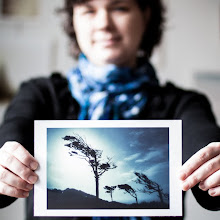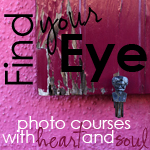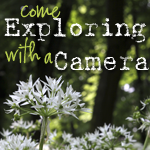 |
| Composed |
I got the idea for playing around with Square Format from the book 150 Photographic Projects for Art Students by John Easterby. I haven't used this format before, so I picked up another book that has become my "encyclopedia" for composition, The Photographer's Eye by Michael Freeman, and looked at the traditional compositions for a square format. With a little bit of information in my head to guide my eye, I was off and exploring Square Format.
Let's see what I learned...
Getting it Square
Unless your main camera is your cell phone, chances are you don't have a square format camera. The typical frame format for digital SLR cameras is 3:2. This means that the length is longer than the height of the frame by one third. A standard size in this format is a 4x6 print. For point-and-shoot cameras the typical frame format is 4:3, where the length is longer than the height by only one quarter. It is closer to square but still not quite the same.
The first step of this exercise is getting a square format. You can always crop the photo into a square format in post-processing. This can teach you a lot, but it doesn't help you to play around with composition at the time of taking the photo so you can make real-time corrections.
What the 150 Photographic Projects book suggests is creating a "pseudo" square format camera by blocking off part of the LCD screen so that you view only a square. Since I intensely dislike using the "live view" mode for composing with the LCD on my dSLR, I decided to modify my point-and-shoot camera (aka my "little camera"). This turned out great, because I was able to leave my little camera in this format for several weeks, even taking it on our vacation to Sicily, while not interfering with my normal photographic process using my primary dSLR camera.
To modify the LCD screen, I just taped a piece of computer paper over the LCD screen as shown below. I used computer paper because I wanted to have a similar color to the rest of the camera, to give a visually consistent border on the frame. Computer paper was not thick enough to block the light coming through the LCD, so I slipped a small piece of dark cardstock behind the taped computer paper and it worked beautifully.
I keep my camera set on center spot for focusing, so I just focus and recomposed as needed, like I do normally. With this minor modification, I was ready to go. My 9-year-old son, observing this little exercise, would occasionally take his camera and put a finger over the edge of the LCD as he composed saying, "Square Format!" In a pinch, that works too!
What follows are some of the compositions I explored. You'll see a caption below each photo. "Cropped" means that the photo was created using the standard format frame for the camera and then a square format composition was explored using cropping in post-processing. "Composed" means that the photo was composed using my modified-LCD-screen as shown above. I still had to crop in post-processing to make the image a true square format, but the composition was decided in-camera.
Random
With the even sides, a square format is very static. This makes it a good candidate for "random" composition, where the eye takes in the whole at one time. This image of oranges on the tree from Sorrento was a good candidate for square format. There wasn't a clear "focal point" with these oranges, it was more about the light, shape and color of them on the tree.
 |
| Cropped |
 |
| Cropped |
With it's even sides, square format provides the unique opportunity to nest a circle in the square. Coming across a pretty door in Cefalù, Sicily, I captured one of the elements carved in wood using square format.
 |
| Composed |
 |
| Composed |
Centered
With square format, you can get a good effect with centering your focal point, something that doesn't work as well in rectangular formats. This best capture of this window in Venice using square format was centered.
 |
| Composed |
 |
| Composed |
 |
| Photo by Harry Callahan |
Just like in rectangular format, diagonal lines can be very interesting compositions. The image below of Murano glass displayed in Venice is an example of both diagonal and centered composition. The thing I noticed when playing around with cropping diagonal images is that you need a different angle on the diagonal line to work in square format. If an image was composed with a diagonal line for a rectangular format, there is a good chance it is at a wrong angle to just crop into square format. In the case of this image, I had played around with different angles and happened to have one that worked for square format.
 |
| Cropped |
With more rectangular subjects, I found that the subject needed to be off-center using square format. A centered image works with a square or circular subject, but not so well for a person or a tree. Cropping this self-portrait of me in Venice solved the problem of too much wall on either side. Normally, I would have taken this in a vertical orientation, but you can't really do that when you set your camera on a step. Square format solved my composition problem.
 |
| Cropped |
 |
| Composed |
Ultimately, what it all comes down to in any composition, regardless of format, is balance. The elements have to be balanced within the frame for a pleasing image. The lead-in image, another scene from the town of Cefalù, Sicily, is a good example of a square format image that doesn't follow any of the specific compositions described above, but balances the elements of color and shape into an interesting photo.
This balcony with the interesting ceramic pots in Taormina, Sicily was another square format image where the composition was derived by balancing the elements of color and line.
 |
| Composed |























Great tutorial Kat - will have to try blocking off my screen on my P&S, I always seem to crop in the editing stage and I'm sure it's a completely different mindset when you do it in-camera.
ReplyDeleteHmmm ... an interesting different view. I've always been one for cropping to the aspect I think is best for an image, although that can play hell with any printing one wants to do, but I've never ended up with a square.
ReplyDeleteThis reminds me of my first camera which was something like a Kodak Instamatic 25 which produced a square image as the only option.
I will have a go at cropping to a square with some of my images a post the results.
What a cool challenge - I like the square format but have never deliberately try to capture images that way.
ReplyDeleteGreat tips there - I don't think in square mode so when I was thinking through it this week, I had to completely adjust. Thanks so much for sharing.
ReplyDeleteA fascinating tutorial, Kat. I've ended up with some square images after cropping, but want to try it with the camera. What fun! Mille grazie!
ReplyDeleteLots of great tips! If you have an iphone, Instagram is in a square format too. I love the look.
ReplyDeleteWhat a neat idea Kat (paper over the LCD)!
ReplyDeleteThank you for always sharing such good 'stuff!"
I like the idea of cropping to a square, I've done it post processing a few times, but never set out to when taking the photo. I'll have to spend some time trying that.
ReplyDeletethanks kat
xo
mo
I absolutely love the first picture. The door, the pot, it is beautiful. I switched over to a photography only blog to make it easier and more reader "friendly".
ReplyDeleteLove your photos! I always learn so much when I visit here. Wish I had the time to visit more! Thanks for sharing your talent and knowledge!
ReplyDeleteI have been sent here by a friend of yours Maureen from Cottage 960 after commenting recently on her blog. I am also an ex pat in Italy with an interest in photography but just as an amateur. I think I may be able to learn a lot from you so am becoming your latest follower.
ReplyDeleteRe "self-portrait of me in Venice" - love the look! It's what I'm striving for on my trip to Italy next March.
ReplyDeleteThanks for the tips. I edited a couple this week in square mode after reading this post. I think it was the best edit for them, not sure I would have thought of editing them like that before reading this.
ReplyDeletei've always like the square format but never tried it. i should! love this kat!
ReplyDeleteI've definitely used the square format when cropping, but never thought of using it while composing. As soon as I'm up and around again I'll give it a try. Love this series, Kat!
ReplyDeleteSuch a fun interpretation! LOVE all of your examples.
ReplyDeleteAwesome photos! Love that first one.
ReplyDeleteI really like the idea of placing that little piece over the lcd screen. I must do that as it's so much easier to visualize the final shot when the screen is already in a square format. Thankyou Kat.
ReplyDeleteLove you diagonal and rule of thirds photos! Have a sweet day!
ReplyDelete-nicolette
http://www.simplycolette.blogspot.com
http://www.photographygetaways.com
great post kat! i love the idea of taping off part of the screen to compose a square shot in the moment. brilliant!
ReplyDeleteBeautiful work Kat! I am glad I stumbled upon your site today.
ReplyDelete-Yari
http://www.yariostovany.com